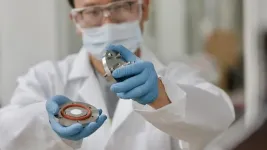New research shows risk of COVID-19 from aerosols to healthcare workers
Analysis shows coughing, deep breathing and shouting creates more than 100-fold greater amounts of aerosols than oxygen therapies, potentially increasing risk to frontline staff who wear only surgical masks
2021-03-31
(Press-News.org) New research published in Anaesthesia (a journal of the Association of Anaesthetists) challenges the guidance that special aerosol precautions are only needed when using oxygen therapies for COVID-19 patients, and raises concerns about safety of staff and patients on hospital wards, if they are not protected from infectious aerosols.
The study set out to examine whether oxygen therapies used for patients with severe COVID-19 produce large amounts of small respiratory particles called aerosols, which can transmit virus and can evade routine precautions used on hospital wards. The study found these oxygen therapies do not produce excessive amounts of aerosols and in fact reduce aerosols suggesting these therapies can be made widely available.
The study also showed that respiratory activities such as coughing and deep breathing are a major source of aerosol particles, and this has the potential to expose healthcare workers to an increased risk of infection. Importantly, the authors make clear that this study used 10 healthy volunteers to produce the aerosols measured, not patients infected with SARS-CoV-2.
The authors of the study, who include Dr Nick Wilson (Royal Infirmary of Edinburgh, NHS Lothian, Scotland), Prof Euan Tovey (University of Sydney), Prof Guy Marks (University of New South Wales, Sydney) and Prof Tim Cook (Royal United Hospitals Bath NHS Foundation Trust, Bath, UK) say that their findings could in part explain why staff working on wards who wear only surgical masks have around two to three times higher rates of infection and hospitalisation than those working in ICU where more complete personal protective equipment such as N95/FFP3 respirator masks are used.
The researchers built a new chamber providing extremely clean air, in which 10 healthy volunteers sat. They breathed into a large cone, and the researchers collected the particles that were breathed out and used a specialised machine called an 'optical particle counter' to measure the number and size of the particles. In contrast to previous studies the researchers collected almost all particles breathed out and this enabled a clear comparison between the amounts of aerosols generated by respiratory activities and oxygen therapies.
First, the volunteers performed respiratory activities including breathing, talking, shouting, coughing and exercising, designed to mimic respiratory activity of patients with respiratory infections such as COVID-19. This showed that increased respiratory activity (such as coughing and deep breathing) which is common in patients with COVID-19 increases aerosols by more than 100 times.
The volunteers then repeated the experiments while receiving oxygen therapies commonly used in hospitalised patients with severe COVID-19, first the delivery of oxygen at high flow into the nose (high flow nasal oxygen) and then oxygen delivered under pressure through a tight-fitting facemask (non-invasive ventilation). Aerosol numbers were not increased and during increased respiratory activities and were actually reduced.
There is much debate over the role of respiratory particles in guidelines for preventing transmission of COVID-19. Larger particles (larger than 1/200th of a millimetre) are traditionally called 'droplets' and are deemed to travel only 1-2 metres from an infected patient before falling to the ground. Aerosols are smaller particles (smaller than 1/200th of a millimetre) and stay floating in the air for prolonged periods, spread further, may accumulate in poorly ventilated spaces, can be inhaled deep into the lungs and bypass looser fitting facemasks. Much current guidance is designed to protect from droplets and infection spread by aerosols is only considered a risk when caused by medical therapies. In this new study, the volunteers produced up to 100 times more aerosol particles with activities such as coughing than they did during treatment with oxygen therapies.
This challenges the current guidelines which state healthcare staff looking after patients with COVID-19 who are coughing and have breathing difficulty only need PPE that protects against the larger droplets. 'Droplet protection' includes surgical masks but does not prevent aerosol particles passing around the edges of the masks and being inhaled. N95/FFP3 respirators which are tightfitting and filter better, block more aerosols but guidelines currently recommend these only for staff looking after patients receiving the advanced oxygen therapies.
Study lead author Dr Nick Wilson explains: "More than 90% of the total number of particles produced by both activities and therapies were the smaller aerosols. Aerosols are important as they can travel long distances in the air, evade loose fitting surgical facemasks and be inhaled deep into the lung. This raises concerns about the safety of those around patients with COVID-19."
Prof Euan Tovey says: "The coughing and laboured breathing common in patients with COVID-19 produces a lot more droplets and aerosols than is produced by patients being treated with oxygen therapies. Surgical facemasks provide inadequate protection against aerosols and staff safety can only be increased by more widespread use of specialised tight-fitting respirators (N95 or FFP3 masks) and increased indoor ventilation. Also, as the respiratory therapies did not significantly increase aerosols, these treatments should be made widely available to patients with COVID-19 who need them."
Prof Guy Marks says: "The study also has implications beyond hospitals. The generation of both droplets and particularly aerosols by everyday breathing activities reinforces the importance of maintaining social distance, having excellent ventilation in buildings and transport, being outside where possible and using effective masks both to protect from breathing in virus and reducing the amount of virus they spread when breathing out."
Prof Tim Cook concludes: "Our findings strongly support the re-evaluation of guidelines to better protect hospital staff, patients and all those on the front line who are dealing with people who have, or are suspected of having, COVID-19."
INFORMATION:
ELSE PRESS RELEASES FROM THIS DATE:
2021-03-31
Rock art of human figures created over thousands of years in Australia's Arnhem Land has been put through a transformative machine learning study to analyse style changes over the years.
The study has tested different styles labelled 'Northern Running figures', 'Dynamic figures', 'Post Dynamic figures' and 'Simple figures with Boomerangs' to understand how these styles relate to one another.
Working with the Mimal and Marrku Traditional Owners of the Wilton River area in Australia's Top End, South Australian researchers led by Flinders University archaeologist Dr Daryl Wesley have taken a closer look at the art of this region.
Flinders researcher Jarrad Kowlessar and the team used machine learning ...
2021-03-31
Highlights
A newly developed tool assesses patients' home dialysis experience.
The 26-item Home Dialysis Care Experience instrument will be a resource for future research use, clinical care, and quality improvement initiatives among home dialysis facilities and organizations.
Washington, DC (March 30, 2021) -- Researchers have developed a new tool to assess patients' opinions and experience concerning home dialysis care. The tool is described in an upcoming issue of CJASN.
Home dialysis, which includes both peritoneal dialysis and home hemodialysis, allows patients to receive their dialysis treatments at home, gives patients independence and flexibility ...
2021-03-30
BOSTON - COVID-19 can have damaging effects on multiple organs in the body, including the brain. A new study led by investigators at Massachusetts General Hospital (MGH) and Beth Israel Deaconess Medical Center (BIDMC) indicates that some hospitalized patients with COVID-19 experience non-convulsive seizures, which may put them at a higher risk of dying. The findings are published in the Annals of Neurology.
"Seizures are a very common complication of severe critical illness. Most of these seizures are not obvious: Unlike seizures that make a person fall down and shake, or convulse, ...
2021-03-30
HOUSTON - (March 30, 2021) - Whether parents prefer a conformance-oriented or independence-oriented supplemental education program for their children depends on political ideology, according to a study of more than 8,500 American parents by a research team from Rice University and the University of Texas at San Antonio.
"Conservative parents have a higher need for structure, which drives their preference for conformance-oriented programs," said study co-author Vikas Mittal, a professor of marketing at Rice's Jones Graduate School of Business. "Many parents ...
2021-03-30
Boulder, Colo., USA: Anthropogenic climate change is one of the foremost scientific and societal challenges. In part, our response to this global challenge requires an enhanced understanding of how the Earth's surface responds to episodes of climatic heating and cooling. As historical records extend back only a few hundred years, we must look back into the ancient rock record to see how the surface of the Earth has responded to shifts between icehouse (presence of ice at the Earth's poles) and greenhouse (no substantial ice at Earth's poles) climates in the past.
In ...
2021-03-30
NEW YORK, NY (March 30, 2021)--Early in the pandemic, neurologists expressed concern that COVID-19 patients with dementia may be at higher risk for complications and mortality.
But those fears have not been realized, according to a new study of patients who were hospitalized with COVID-19 during the first wave of the pandemic in New York City. The study, led by James Noble, MD, MS, associate professor of neurology at Columbia University Vagelos College of Physicians and Surgeons and the Taub Institute for Research on Alzheimer's Disease and the Aging Brain, and Amro Harb, a Vagelos medical student, was published this month in ...
2021-03-30
A year ago scientists everywhere were scrambling to get their minds around the SARS-CoV-2, a novel coronavirus that caused the pandemic from which we are only now beginning to emerge. The world clung to every new development, every bit of science that could provide clues to managing life in the presence of this mysterious killer.
Many science-backed COVID-19 management concepts remain unchanged to this day: handwashing with soap and warm water disrupts the virus' lipid membrane. Social distancing can attenuate the virus's spread, ideally keeping it out of a host until it degrades. Other notions, such as droplet contact being the primary mode of transmission, were modified when emerging evidence showed that under ...
2021-03-30
Not all species may travel the same path to existence, at least according to new findings from the University of Colorado Boulder and collaborators.
This new research, out now in Science, looked at a newly discovered, endangered songbird located only in South America--the Iberá Seedeater--and found that this bird followed a very rare evolutionary path to come into existence at a much faster pace than the grand majority of species.
By comparing this bird to a closely related neighbor (the Tawny-Bellied Seedeater) in the same group (the southern capuchino seedeaters), the researchers determined that genetic shuffling of existing variations, rather than new random mutations, brought this species into existence--and their ...
2021-03-30
CORVALLIS, Ore. - Oregon State University researchers broadcast marbled murrelet calls in mature forests and found that the threatened seabirds' choice of breeding locations is strongly influenced by whether they hear other murrelets in the area.
The research by scientists in the OSU College of Forestry and College of Agricultural Sciences is important because the elusive seabird's populations are in decline and recovery may be hindered by there being too few birds around to provide information to each other about where to nest.
Findings were published in Ornithology, the the flagship journal of the American Ornithologists Union.
"The odds that marbled murrelets would ...
2021-03-30
On sultry summer afternoons, heating, ventilation and air conditioning (HVAC) systems provide much-needed relief from the harsh heat and humidity. These systems, which often come with dehumidifiers, are currently not energy efficient, guzzling around 76% of the electricity in commercial and residential buildings.
In a new study, Texas A&M University researchers have described an organic material, called polyimides, that uses less energy to dry air. Furthermore, the researchers said polyimide-based dehumidifiers can bring down the price of HVAC systems, which currently cost thousands of dollars.
"In this study, we took an existing and rather robust polymer and then improved its dehumidification efficiency," said Hae-Kwon Jeong, McFerrin Professor in the Artie McFerrin ...
LAST 30 PRESS RELEASES:
[Press-News.org] New research shows risk of COVID-19 from aerosols to healthcare workers
Analysis shows coughing, deep breathing and shouting creates more than 100-fold greater amounts of aerosols than oxygen therapies, potentially increasing risk to frontline staff who wear only surgical masks


